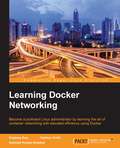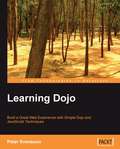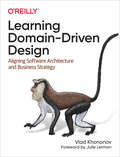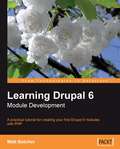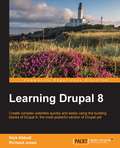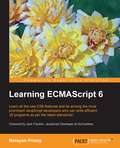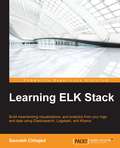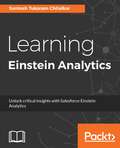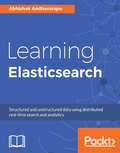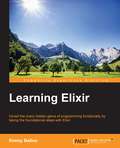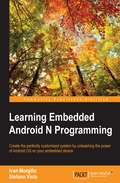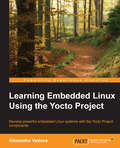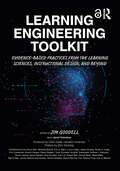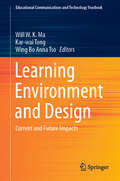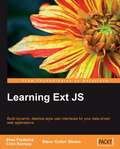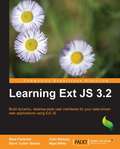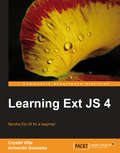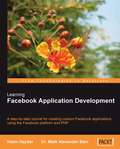- Table View
- List View
Learning Docker Networking
by Rajdeep Dua Santosh Kumar Konduri Vaibhav KohliBecome a proficient Linux administrator by learning the art of container networking with elevated efficiency using Docker About This Book * Set up, configure, and monitor a virtual network of containers using a bridge network and virtual switches * Master the skill of networking Docker Containers using frameworks such as Kubernetes, Docker Swarm, and Mesosphere * Acquire hands-on experience through practical examples of Docker networking spanning multiple containers, over multiple hosts, clubbed with various frameworks Who This Book Is For If you are a Linux administrator who wants to learn networking using Docker to ensure the efficient administration of core elements and applications, then this book is for you. Basic knowledge of LXC/Docker is assumed. What You Will Learn * Get to know the basics of networking and see how Docker networking works * Expose the strengths and weaknesses of the current Docker network implementation and third party landscape * Understand Docker networking spanning multiple containers over multiple hosts through practical examples * Observe the pitfalls of Docker networking and how to overcome them * Learn how Docker networking works for Docker Swarm and Kubernetes * Configure Networking using Docker's container network model (CNM) * Explore OpenvSwitch to connect contain In Detail Docker is a Linux container implementation that enables the creation of light weight portable development and production environments. These environments can be updated incrementally. Docker achieves this by leveraging containment principles like cgroups and Linux namespaces along with Overlay filesystem based portable images. Docker provides the networking primitives that allow administrators to specify how different containers network with each application and connect each of its components, then distribute them across a large number of servers and ensure coordination between them irrespective of the host or VM they are running in. This book will show you how to create, deploy, and manage a virtual network for connecting containers spanning single or multiple hosts. Style and approach This step-by-step guide covers the fundamentals relating to typical applications with a practical approach. There is a focus on providing the practical skills required to develop applications, with a summary of the key concepts where necessary.
Learning Dojo
by Peter SvenssonThe book is an example-based tutorial. Once the basics are done, it takes the reader through creating a number of examples, each focussed on a different interface task or visual effect. This book is for web developers with JavaScript knowledge, who want to use Dojo for developing dynamic Web 2.0 applications. Readers need basic web-page creation skills, HTML and CSS, and should be comfortable with the syntax of JavaScript.
Learning Domain-Driven Design: Aligning Software Architecture and Business Strategy
by Vlad KhononovBuilding software is harder than ever. As a developer, you not only have to chase ever-changing technological trends but also need to understand the business domains behind the software. This practical book provides you with a set of core patterns, principles, and practices for analyzing business domains, understanding business strategy, and, most importantly, aligning software design with its business needs.Author Vlad Khononov shows you how these practices lead to robust implementation of business logic and help to future-proof software design and architecture. You'll examine the relationship between domain-driven design (DDD) and other methodologies to ensure you make architectural decisions that meet business requirements. You'll also explore the real-life story of implementing DDD in a startup company.With this book, you'll learn how to:Analyze a company's business domain to learn how the system you're building fits its competitive strategyUse DDD's strategic and tactical tools to architect effective software solutions that address business needsBuild a shared understanding of the business domains you encounterDecompose a system into bounded contextsCoordinate the work of multiple teamsGradually introduce DDD to brownfield projects
Learning Drupal 6 Module Development
by Matt ButcherThis book is written for PHP developers who want to add custom features to Drupal. You will need to know the basics of PHP and MySQL programming, but no experience of programming Drupal is required, although you will be expected to be familiar with the basic operation of Drupal.
Learning Drupal 8
by Richard Jones Nick AbbottIf you want to learn to use Drupal 8 for the first time, or you are transitioning over from a previous version of Drupal, this is the book for you. No knowledge of PHP, MySQL, or HTML is assumed or required
Learning Dynamics NAV Patterns: Create Solutions That Are Easy To Maintain, Quick To Upgrade, And Follow Proven Concepts And Designs
by Mark BrummelCreate solutions that are easy to maintain, quick to upgrade, and follow proven concepts and designs About This Book * Design software that is maintainable outside the ecosystem of their creators * Ensure quality by following patterns that have been proved to work * Over two dozen practical Architectural and Design patterns Who This Book Is For Learning Dynamics NAV Patterns is intended for developers, architects, (technical) consultants, and application managers. You may have very little or no knowledge about NAV patterns, but you should be acquainted with programming. What You Will Learn * Apply object-oriented practices to C/AL programming * Structure your application to avoid merge conflicts * Refactor legacy code and avoid anti-patterns * Design decision trees to decide when to use which patterns * Clone codes and their application in Dynamics NAV * Make your application extensible by creating predefined hooks and facades In Detail Microsoft Dynamics NAV is a complete ERP system, which also contains a robust set of development tools to support customization and enhancement. These include an object designer for each of the seven application object types, a business application oriented programming language with .NET interface capability, a compiler, a debugger, and programming testing language support. Learning Dynamics NAV Patterns will guide you through the NAV way of solving problems. This book will first introduce you to patterns and the software architecture of the NAV and then help you to build an example application. Then, it walks you through the details of architectural patterns, design patterns, and implementation patterns. This book will also talk about anti-patterns and handling legacy code. Finally, it teaches you to build solutions using patterns. Proven patterns and best practices will help you create better solutions that are easy to maintain in larger teams across several locations. It will guide you through combining abstract patterns using easy-to-understand examples and will help you decide which patterns to use in which scenarios. Style and approach This book explains the concepts of patterns, code structuring, and object-oriented concepts in a way that is easy to understand for Dynamics NAV specialists through practical examples.
Learning ECMAScript 6
by Narayan PrustyIf you are a JavaScript developer with basic development, and now want to learn about the latest features in order to develop better client-side programs with JavaScript, then this book is for you.
Learning ELK Stack
by Saurabh ChhajedBuild mesmerizing visualizations, analytics, and logs from your data using Elasticsearch, Logstash, and Kibana About This Book * Solve all your data analytics problems with the ELK stack * Explore the power of Kibana4 search and visualizations built over Elasticsearch queries and learn about the features and plugins of Logstash * Develop a complete data pipeline using the ELK stack Who This Book Is For If you are a developer or DevOps engineer interested in building a system that provides amazing insights and business metrics out of data sources, of various formats and types, using the open source technology stack that ELK provides, then this book is for you. Basic knowledge of Unix or any programming language will be helpful to make the most out of this book. What You Will Learn * Install, configure, and run Elasticsearch, Logstash, and Kibana * Understand the need for log analytics and the current challenges in log analysis * Build your own data pipeline using the ELK stack * Familiarize yourself with the key features of Logstash and the variety of input, filter, and output plugins it provides * Build your own custom Logstash plugin * Create actionable insights using charts, histograms, and quick search features in Kibana4 * Understand the role of Elasticsearch in the ELK stack In Detail The ELK stack--Elasticsearch, Logstash, and Kibana, is a powerful combination of open source tools. Elasticsearch is for deep search and data analytics. Logstash is for centralized logging, log enrichment, and parsing. Kibana is for powerful and beautiful data visualizations. In short, the Elasticsearch ELK stack makes searching and analyzing data easier than ever before. This book will introduce you to the ELK (Elasticsearch, Logstash, and Kibana) stack, starting by showing you how to set up the stack by installing the tools, and basic configuration. You'll move on to building a basic data pipeline using the ELK stack. Next, you'll explore the key features of Logstash and its role in the ELK stack, including creating Logstash plugins, which will enable you to use your own customized plugins. The importance of Elasticsearch and Kibana in the ELK stack is also covered, along with various types of advanced data analysis, and a variety of charts, tables ,and maps. Finally, by the end of the book you will be able to develop full-fledged data pipeline using the ELK stack and have a solid understanding of the role of each of the components. Style and approach This book is a step-by-step guide, complete with various examples to solve your data analytics problems by using the ELK stack to explore and visualize data.
Learning Einstein Analytics: Unlock critical insights with Salesforce Einstein Analytics
by Santosh ChitalkarLearn to confidently setup and create app, lenses, dashboards using Salesforce Einstein Analytics. Key Features Explore Einstein analytics on desktop as well as mobile platforms Turn data into smarter sales with Einstein Analytics for Sales Visualize your data with preloaded as well as customized dashboards Book Description Salesforce Einstein analytics aka Wave Analytics is a cloud-based platform which connects data from the multiple sources and explores it to uncover insights. It empowers sales reps, marketers, and analysts with the insights to make customer interactions smarter, without building mathematical models. You will learn to create app, lenses, dashboards and share dashboards with other users. This book starts off with explaining you fundamental concepts like lenses, step, measures and sets you up with Einstein Analytics platform. We then move on to creating an app and here you will learn to create datasets, dashboards and different ways to import data into Analytics. Moving on we look at Einstein for sales, services, and marketing individually. Here you will learn to manage your pipeline, understand important business drivers and visualize trends. You will also learn features related to data monitoring tools and embedding dashboards with lightning, visualforce page and mobile devices. Further, you will learn advanced features pertaining to recent advancements in Einstein which include machine learning constructs and getting predictions for events. By the end of this book, you will become proficient in the Einstein analytics, getting insights faster and understanding your customer in a better way. What you will learn - Create app, lenses, and dashboards using Einstein. - Visualize data utilizing all the widgets available with Einstein. - Understand Einstein for Sales, Service, and Marketing separately. - Use Data monitoring tools to monitor data flow and system jobs. - Abstract machine learning constructs and make predictions on events Who this book is for This book is for data scientists, business users, developers who want to explore business data using the Salesforce Einstein Analytics. Knowledge of the Salesforce platform is required.
Learning Elastic Stack 6.0: A beginner’s guide to distributed search, analytics, and visualization using Elasticsearch, Logstash and Kibana
by Saurabh Chhajed Marcelo Ochoa Pranav Shukla Sharath KumarKey Features - Get to grips with the new features introduced in Elastic Stack 6.0 - Get valuable insights from your data by working with the different components of the Elastic stack such as Elasticsearch, Logstash, Kibana, X-Pack, and Beats - Includes handy tips and techniques to build, deploy and manage your Elastic applications efficiently on-premise or on the cloud Book Description The Elastic Stack is a powerful combination of tools for distributed search, analytics, logging, and visualization of data from medium to massive data sets. The newly released Elastic Stack 6.0 brings new features and capabilities that empower users to find unique, actionable insights through these techniques. This book will give you a fundamental understanding of what the stack is all about, and how to use it efficiently to build powerful real-time data processing applications. After a quick overview of the newly introduced features in Elastic Stack 6.0, you’ll learn how to set up the stack by installing the tools, and see their basic configurations. Then it shows you how to use Elasticsearch for distributed searching and analytics, along with Logstash for logging, and Kibana for data visualization. It also demonstrates the creation of custom plugins using Kibana and Beats. You’ll find out about Elastic X-Pack, a useful extension for effective security and monitoring. We also provide useful tips on how to use the Elastic Cloud and deploy the Elastic Stack in production environments. On completing this book, you’ll have a solid foundational knowledge of the basic Elastic Stack functionalities. You’ll also have a good understanding of the role of each component in the stack to solve different data processing problems. What you will learn - Familiarize yourself with the different components of the Elastic Stack - Get to know the new functionalities introduced in Elastic Stack 6.0 - Effectively build your data pipeline to get data from terabytes or petabytes of data into Elasticsearch and Logstash for searching and logging - Use Kibana to visualize data and tell data stories in real-time - Secure, monitor, and use the alerting and reporting capabilities of Elastic Stack - Take your Elastic application to an on-premise or cloud-based production environment
Learning Elastic Stack 7.0: Distributed search, analytics, and visualization using Elasticsearch, Logstash, Beats, and Kibana, 2nd Edition
by Pranav Shukla Sharath Kumar M NA beginner's guide to storing, managing, and analyzing data with the updated features of Elastic 7.0Key FeaturesGain access to new features and updates introduced in Elastic Stack 7.0Grasp the fundamentals of Elastic Stack including Elasticsearch, Logstash, and KibanaExplore useful tips for using Elastic Cloud and deploying Elastic Stack in production environmentsBook DescriptionThe Elastic Stack is a powerful combination of tools for techniques such as distributed search, analytics, logging, and visualization of data. Elastic Stack 7.0 encompasses new features and capabilities that will enable you to find unique insights into analytics using these techniques. This book will give you a fundamental understanding of what the stack is all about, and help you use it efficiently to build powerful real-time data processing applications.The first few sections of the book will help you understand how to set up the stack by installing tools, and exploring their basic configurations. You’ll then get up to speed with using Elasticsearch for distributed searching and analytics, Logstash for logging, and Kibana for data visualization. As you work through the book, you will discover the technique of creating custom plugins using Kibana and Beats. This is followed by coverage of the Elastic X-Pack, a useful extension for effective security and monitoring. You’ll also find helpful tips on how to use Elastic Cloud and deploy Elastic Stack in production environments. By the end of this book, you’ll be well versed with the fundamental Elastic Stack functionalities and the role of each component in the stack to solve different data processing problems.What you will learnInstall and configure an Elasticsearch architectureSolve the full-text search problem with ElasticsearchDiscover powerful analytics capabilities through aggregations using ElasticsearchBuild a data pipeline to transfer data from a variety of sources into Elasticsearch for analysisCreate interactive dashboards for effective storytelling with your data using KibanaLearn how to secure, monitor and use Elastic Stack’s alerting and reporting capabilitiesTake applications to an on-premise or cloud-based production environment with Elastic StackWho this book is forThis book is for entry-level data professionals, software engineers, e-commerce developers, and full-stack developers who want to learn about Elastic Stack and how the real-time processing and search engine works for business analytics and enterprise search applications. Previous experience with Elastic Stack is not required, however knowledge of data warehousing and database concepts will be helpful.
Learning Elasticsearch
by Abhishek AndhavarapuStore, search, and analyze your data with ease using Elasticsearch 5.x About This Book • Get to grips with the basics of Elasticsearch concepts and its APIs, and use them to create efficient applications • Create large-scale Elasticsearch clusters and perform analytics using aggregation • This comprehensive guide will get you up and running with Elasticsearch 5.x in no time Who This Book Is For If you want to build efficient search and analytics applications using Elasticsearch, this book is for you. It will also benefit developers who have worked with Lucene or Solr before and now want to work with Elasticsearch. No previous knowledge of Elasticsearch is expected. What You Will Learn • See how to set up and configure Elasticsearch and Kibana • Know how to ingest structured and unstructured data using Elasticsearch • Understand how a search engine works and the concepts of relevance and scoring • Find out how to query Elasticsearch with a high degree of performance and scalability • Improve the user experience by using autocomplete, geolocation queries, and much more • See how to slice and dice your data using Elasticsearch aggregations. • Grasp how to use Kibana to explore and visualize your data • Know how to host on Elastic Cloud and how to use the latest X-Pack features such as Graph and Alerting In Detail Elasticsearch is a modern, fast, distributed, scalable, fault tolerant, and open source search and analytics engine. You can use Elasticsearch for small or large applications with billions of documents. It is built to scale horizontally and can handle both structured and unstructured data. Packed with easy-to- follow examples, this book will ensure you will have a firm understanding of the basics of Elasticsearch and know how to utilize its capabilities efficiently. You will install and set up Elasticsearch and Kibana, and handle documents using the Distributed Document Store. You will see how to query, search, and index your data, and perform aggregation-based analytics with ease. You will see how to use Kibana to explore and visualize your data. Further on, you will learn to handle document relationships, work with geospatial data, and much more, with this easy-to-follow guide. Finally, you will see how you can set up and scale your Elasticsearch clusters in production environments. Style and approach This comprehensive guide will get you started with Elasticsearch 5.x, so you build a solid understanding of the basics. Every topic is explained in depth and is supplemented with practical examples to enhance your understanding.
Learning Elixir
by Kenny BallouUnveil many hidden gems of programming functionally by taking the foundational steps with ElixirAbout This BookExplore the functional paradigms of programming with Elixir through use of helpful examplesConcise step-by-step instructions to teach you difficult technical conceptsBridge the gap between functional programming and ElixirWho This Book Is ForThis book targets developers new to Elixir, as well as Erlang, in order to make them feel comfortable in functional programming with Elixir, thus enabling them to develop more scalable and fault-tolerant applications.Although no knowledge of Elixir is assumed, some programming experience with mainstream Object-Oriented programming languages such a Ruby, Python, Java, C# would be beneficial.What You Will LearnExplore Elixir to create resilient, scalable applicationsCreate fault-tolerant applicationsBecome better acquainted with Elixir code and see how it is structured to build and develop functional programsLearn the basics of functional programmingGain an understanding of effective OTP principlesDesign program-distributed applications and systemsWrite and create branching statements in ElixirLearn to do more with less using Elixir's metaprogrammingBe familiar with the facilities Elixir provides for metaprogramming, macros, and extending the Elixir languageIn DetailElixir, based on Erlang's virtual machine and ecosystem, makes it easier to achieve scalability, concurrency, fault tolerance, and high availability goals that are pursued by developers using any programming language or programming paradigm. Elixir is a modern programming language that utilizes the benefits offered by Erlang VM without really incorporating the complex syntaxes of Erlang.Learning to program using Elixir will teach many things that are very beneficial to programming as a craft, even if at the end of the day, the programmer isn't using Elixir. This book will teach you concepts and principles important to any complex, scalable, and resilient application. Mostly, applications are historically difficult to reason about, but using the concepts in this book, they will become easy and enjoyable. It will teach you the functional programing ropes, to enable them to create better and more scalable applications, and you will explore how Elixir can help you achieve new programming heights. You will also glean a firm understanding of basics of OTP and the available generic, provided functionality for creating resilient complex systems. Furthermore, you will learn the basics of metaprogramming: modifying and extending Elixir to suite your needs.Style and approach An exploration of functional programming and Elixir with easy to follow examples using Elixir and the functional style. All the topics, concepts, and principles covered are clearly and concisely explained with either code examples or in depth discussions, or both!
Learning Embedded Android N Programming
by Ivan Morgillo Stefano ViolaCreate the perfectly customized system by unleashing the power of Android OS on your embedded device About This Book * Understand the system architecture and how the source code is organized * Explore the power of Android and customize the build system * Build a fully customized Android version as per your requirements Who This Book Is For If you are a Java programmer who wants to customize, build, and deploy your own Android version using embedded programming, then this book is for you. What You Will Learn * Master Android architecture and system design * Obtain source code and understand the modular organization * Customize and build your first system image for the Android emulator * Level up and build your own Android system for a real-world device * Use Android as a home automation and entertainment system * Tailor your system with optimizations and add-ons * Reach for the stars: look at the Internet of Things, entertainment, and domotics In Detail Take a deep dive into the Android build system and its customization with Learning Embedded Android Programming, written to help you master the steep learning curve of working with embedded Android. Start by exploring the basics of Android OS, discover Google's "repo" system, and discover how to retrieve AOSP source code. You'll then find out to set up the build environment and the first AOSP system. Next, learn how to customize the boot sequence with a new animation, and use an Android "kitchen" to "cook" your custom ROM. By the end of the book, you'll be able to build customized Android open source projects by developing your own set of features. Style and approach This step-by-step guide is packed with various real-world examples to help you create a fully customized Android system with the most useful features available.
Learning Embedded Linux Using the Yocto Project
by Alexandru VaduvaIf you are a Yocto and Linux enthusiast who wants to build embedded Linux systems but do not have the knowledge to do it, this is the book for you. It will also help those of you who have a bit of knowledge about Linux and the embedded world and are keen on learning more about the technology. This book will provide you with the skills needed to successfully interact with the Yocto Project components regardless of the fact that you are new to embedded development or an expert.
Learning Engineering Toolkit: Evidence-Based Practices from the Learning Sciences, Instructional Design, and Beyond
by Janet Kolodner Jim GoodellThe Learning Engineering Toolkit is a practical guide to the rich and varied applications of learning engineering, a rigorous and fast-emerging discipline that synthesizes the learning sciences, instructional design, engineering design, and other methodologies to support learners. As learning engineering becomes an increasingly formalized discipline and practice, new insights and tools are needed to help education, training, design, and data analytics professionals iteratively develop, test, and improve complex systems for engaging and effective learning. Written in a colloquial style and full of collaborative, actionable strategies, this book explores the essential foundations, approaches, and real-world challenges inherent to ensuring participatory, data-driven, learning experiences across populations and contexts.
Learning Engineering Toolkit: Evidence-Based Practices from the Learning Sciences, Instructional Design, and Beyond
by Janet Kolodner Jim GoodellThe Learning Engineering Toolkit is a practical guide to the rich and varied applications of learning engineering, a rigorous and fast-emerging discipline that synthesizes the learning sciences, instructional design, engineering design, and other methodologies to support learners. As learning engineering becomes an increasingly formalized discipline and practice, new insights and tools are needed to help education, training, design, and data analytics professionals iteratively develop, test, and improve complex systems for engaging and effective learning. Written in a colloquial style and full of collaborative, actionable strategies, this book explores the essential foundations, approaches, and real-world challenges inherent to ensuring participatory, data-driven, learning experiences across populations and contexts."Introduction: What Is Learning Engineering?", "Chapter 1: Learning Engineering is a Process", and "Chapter 2: Learning Engineering Applies the Learning Sciences" are freely available as downloadable Open Access PDFs at http://www.taylorfrancis.com under a Creative Commons Attribution-Non Commercial-No Derivatives (CC-BY-NC-ND) 4.0 license.
Learning Environment and Design: Current and Future Impacts (Educational Communications and Technology Yearbook)
by Wing Bo Anna Tso Will W. K. Ma Kar-Wai TongThis special edition of the Educational Communications and Technology Yearbook Series bears a title of “Learning Environment and Design: Current and Future Impact”. It provides a timely forum to share theoretical and practical insights in both the local and international contexts in response to the fact that new media and technologies have infiltrated and shaped the learning environments from mere physical spaces into multifaceted possibilities, impacting the ways individuals teach and learn. Designs of learning environments to harness technologies appropriately to engage learners better, as well as the roles of learners and educators play in this changing learning environment, are examples of important global issues in the discourse of the contemporary educational developments. Having gathered a diverse collection of research papers written by scholars and practitioners in the fields of education, communication and humanities across Asia, Australasia, Europe and the United States, this book gives readers a cross-cultural background on the developments of technological designs and educational practices, investigating areas in redefining of quality education; online learning and blended learning; new media in education; gamification, AI, and innovative learning technologies. Aimed to catalyze knowledge exchanges and provide fresh views on interdisciplinary research, the book sheds light on how emerging technologies can be adapted in the fields of education and communication, so as to facilitate the current and future designs of learning environments to improve learners’ performances.
Learning Ext JS
by Shea Frederick Colin RamsayThe book provides plenty of fun example code and screenshots to guide you through the creation of examples to assist with learning. By taking a chapter-by-chapter look at each major aspect of the Ext JS framework, the book lets you digest the available features in small, easily understandable, chunks, allowing you to start using the library for your development needs immediately. This book is written for Web Application Developers who are familiar with HTML but may have little to no experience with JavaScript application development. If you are starting to build a new web application, or are re-vamping an existing web application, then this book is for you.
Learning Ext JS - Fourth Edition
by Carlos A. Mendez Villa CrysfelIf you are a JavaScript developer who now wants to use the Ext JS framework, this is the book for you. This guide is useful to you whether you're new to Ext JS 5 or are a seasoned expert.<P><P> Experience in HTML, CSS, and JavaScript is required in order to understand and get the most out of this book.
Learning Ext JS 3.2
by Shea Frederick Colin Ramsay Nigel White Steve 'Cutter' BladesThe book provides plenty of fun example code and screenshots to guide you through the creation of examples to assist with learning. By taking a chapter-by-chapter look at each major aspect of the Ext JS framework, the book lets you digest the available features in small, easily understandable chunks, allowing you to start using the library for your development needs immediately. This book is written for Web Application Developers who are familiar with HTML but may have little to no experience with JavaScript application development. If you are starting to build a new web application, or are re-vamping an existing web application, then this book is for you.
Learning Ext JS 4
by Crysfel Villa Armando GonzalezThe book is a step-by-step tutorial full of example code and explanations to help a beginner learn Ext JS thoroughly. This book will help you to learn Ext JS from scratch, it would be better if you have some JavaScript knowledge. Knowledge of HTML and CSS3 would be helpful but not required.
Learning F# Functional Data Structures and Algorithms
by Adnan MasoodIf you have just started your adventure with F#, then this book will help you take the right steps to become a successful F# coder. An intermediate knowledge of imperative programming concepts, and a basic understanding of the algorithms and data structures in .NET environments using the C# language and BCL (Base Class Library), would be helpful.
Learning FPGAs: Digital Design for Beginners with Mojo and Lucid HDL
by Justin RajewskiLearn how to design digital circuits with FPGAs (field-programmable gate arrays), the devices that reconfigure themselves to become the very hardware circuits you set out to program. With this practical guide, author Justin Rajewski shows you hands-on how to create FPGA projects, whether you’re a programmer, engineer, product designer, or maker. You’ll quickly go from the basics to designing your own processor.Designing digital circuits used to be a long and costly endeavor that only big companies could pursue. FPGAs make the process much easier, and now they’re affordable enough even for hobbyists. If you’re familiar with electricity and basic electrical components, this book starts simply and progresses through increasingly complex projects.Set up your environment by installing Xilinx ISE and the author’s Mojo IDELearn how hardware designs are broken into modules, comparable to functions in a software programCreate digital hardware designs and learn the basics on how they’ll be implemented by the FPGABuild your projects with Lucid, a beginner-friendly hardware description language, based on Verilog, with syntax similar to C/C++ and Java
Learning Facebook Application Development
by Hasin Hayder Mark Alexander Bain DrThis book builds on your knowledge as a PHP developer to provide a fast-paced, step-by-step tutorial in building Facebook applications. The book is packed with example code and demo applications, so that you can see techniques in action. Along the way we provide quick references to the most important aspects of the API, so you can refer back as you develop your own applications with the book. This book is for PHP5 developers who want to create custom Facebook applications. It assumes no knowledge of the Facebook API or Platform, but does assume that you are a Facebook user.
